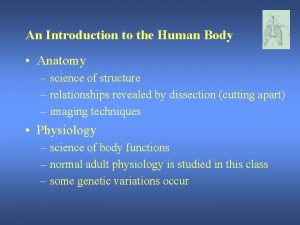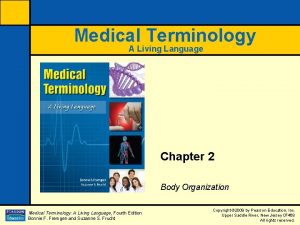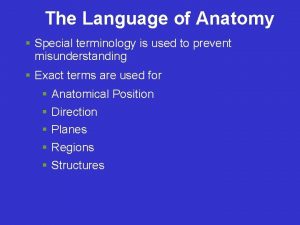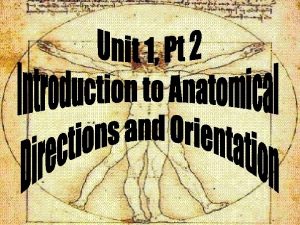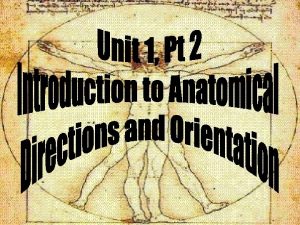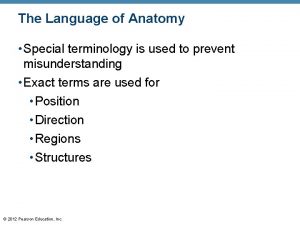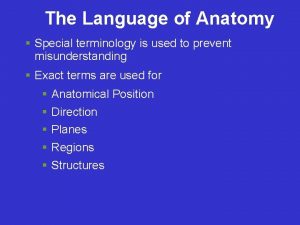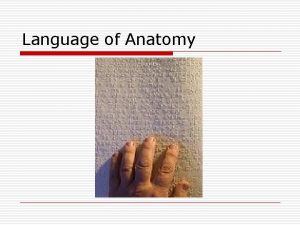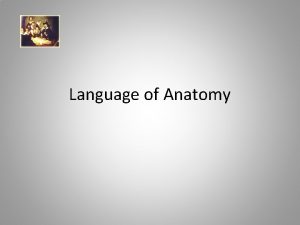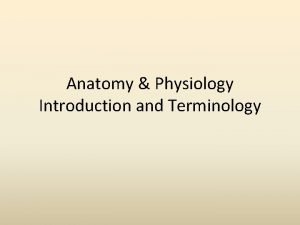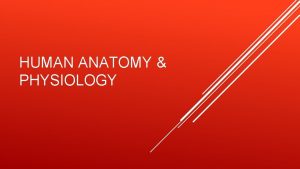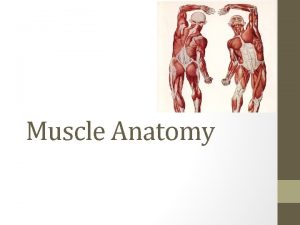The Language of Anatomy Special terminology is used

























- Slides: 25


The Language of Anatomy • Special terminology is used to prevent misunderstanding • Exact terms are used for • Regions • Direction • Position • Structures

The Language of Anatomy: Little History A • Humans have been cutting open cadavers & dissecting corpses almost since the beginning of recorded human history. • Ancient Egyptians mummified their dead by cutting open bodies, dissecting out organs & preserving remains. • Ancient Greeks pursued human dissection, in much more of a scientific vein. Two early Greek physicians, Erasistratus (“first physiologist”) & Herophilus (“founder of human anatomy”) made the first systematic, scientific explorations of the human body. • Herophilus dissected the entire human body & differed from the authority at the time, Aristotle, when he claimed that consciousness was stored in the brain rather than in the heart. • Erasistratus explained the workings of human organs in mechanical terms. • The interest in human dissection almost “died” with the burning of the library of Alexandria & the widespread introduction of Christianity, when it became impossible to dissect human bodies anywhere in the Hellenistic world. For hundreds of years the European world valued the sanctity of the church more than scientific inquiry.

The Language of Anatomy: Little History A • Galen’s Anatomical Influence • The first of the great anatomists was Galen of Pergamon (AD 130 -200) who made vast achievements in the understanding of the heart, the nervous system & the mechanics of breathing. • Because human dissection was forbidden, he performed many of his dissections on Barbary apes, which he considered similar enough to the human form. • The system of anatomy he developed was so influential that it was used for the next 1400 years. Galen continued to be influential into the 16 th century, when a young & rebellious physician began the practice of using real human bodies to study the inner workings of the human body.

The Language of Anatomy: Little History A • Andreas Vesalius • As a child, Vesalius would catch & dissect small animals & later, as a medical student, he would obtain human remains to study. • At age 18, he entered the University of Paris, where they adhered to the works of Hippocrates & Galen. Medical professors thought it below themselves to perform dissections. During demonstrations, the professor would lecture on high as a barber-surgeon did the actual cutting on the dissection floor. • In France, physicians could obtain bodies to study, but lowly students, such as Vesalius, did not have direct access to any of these bodies. He raided the gallows of Paris for half-decomposed bodies & skeletons to dissect. Sometimes he would find the courage to steal cadavers from the mound of Monfaucon, where bodies of executed criminals were hung until they disintegrated. • During only his second anatomical lecture, Vesalius stepped onto the dissecting floor, took the knife away from the barber-surgeon & began cutting at the cadaver himself, demonstrating his great skill with the knife.

Anatomical Position • Body upright • Hands at sides • Palms facing forward • Feet together, flat on ground & facing forward • Eyes open Go ahead & stand on up!

Anatomical Position – Supine vs. Prone • Supine – • Lying with the front or face & hands facing upward • Prone – • Lying with the front or face & hands facing downward

Directional Terminology • • • Superior (cephalic/cranial) vs. Inferior (caudal) Anterior (ventral) vs. Posterior (dorsal) Lateral vs. Medial (mesial) Proximal vs. Distal Superficial vs. Deep

Superior vs. Inferior �Superior (cranial/ cephalic) – Superior Inferior �Toward the head �i. e. - The forehead is superior to the nose. �Inferior (caudal) – �Away from the head �i. e. - The navel is inferior to the breastbone.

Anterior vs. Posterior • Anterior (ventral) – • Toward the front of the body • i. e. - The breastbone is anterior to the spine. • Posterior (dorsal) – • Toward the back of the body • i. e. - The heart is posterior to the breastbone. Anterior (Ventral) Posterior (Dorsal)

Medial vs. Lateral �Medial – �Toward the midline of the body �i. e. - The heart is medial to the arm. Medial Lateral �Lateral – �Away from the midline of the body �i. e. - The arms are lateral to the chest.

Proximal vs. Distal �Proximal – �Closer to the origin of the body part or the point of attachment of a limb to the body trunk �i. e. - The elbow is proximal to the wrist. �Distal – �Farther from the origin of a body part or the point of attachment of a limb to the body trunk �i. e. - The knee is distal to the thigh.

Superficial vs. Deep • Superficial (external) – • Toward or at the body surface • i. e. - The skin is superficial to the skeleton. • Deep (internal) – • Away from the body surface • i. e. - The lungs are deep to the ribcage.

3 2 1 4 3 5 6

Anatomical Planes & Sections • Frontal (coronal) – divides the body into anterior/ posterior parts • Transverse (horizontal) – divides the body into superior/ inferior parts • Also known as a cross-section

Anatomical Planes & Sections • Sagittal – divides the body into right & left parts Midline/midsagittal/median • Parasagittal – divides the body into unequal right & left sides/off-centered Sagittal (midsagittal) plane Para Midline

Anatomical Planes & Sections

1 3 2 4 5

Body Cavities • Cavity – hollow area within the body • Dorsal body cavity • Cranial cavity houses the brain • Spinal cavity houses the spinal cord • Ventral body cavity • Thoracic cavity houses heart, lungs & others • Abdominopelvic cavity houses digestive system & most urinary system organs

Anterior VIEW of Body Cavities Key: Cranial cavity Dorsal body cavity Ventral body cavity Vertebral cavity Thoracic cavity (contains heart and lungs) Superior mediastinum Pleural cavity Pericardial cavity within the mediastinum Diaphragm Abdominal cavity (contains digestive viscera) Abdominopelvic cavity Ventral body cavity (thoracic and abdominopelvic cavities) Pelvic cavity (contains bladder, reproductive organs, and rectum) (b) Anterior view Figure 1. 9 b

Thoracic Cavity Superior Mediastinum Pleural Cavity Pericardial cavity • Divided into: • Diaphragm – flat muscular sheet that divides ventral cavity into superior thoracic cavity & inferior adbominopelvic cavity • Lateral Pleural Cavities – contain lungs • Mediastinum – contains heart, esophagus, thymus, trachea • Pericardial Cavity – small chamber that surrounds heart

Abdominopelvic Cavity • Abdominal Cavity – stomach, intestines, spleen, liver & other organs • Pelvic Cavity – bladder, some reproductive organs, rectum • Serous membranes – lines walls of internal cavities & covers surface of viscera • Visceral – covers visceral organs • Parietal – lines inner surface of body wall or chamber

Body Regions Use this diagram to fill in & colorcode your own!

Abdominopelvic quadrants & regions Use this diagram to identify each AP Quadrant & Region!

Abdominopelvic REGIONS R&L hypochondriac = cartilage Epigastric epi = on gastric = stomach R & L lumbar = back Umbilical R & L iliac (inguinal) - hip Hypogastric hypo = under HEH LUL IHI
 Brisbane classification liver resection
Brisbane classification liver resection Human anatomy terminology
Human anatomy terminology Abdominopelvic cavity regions
Abdominopelvic cavity regions Anatomy and physiology chapter 8 special senses
Anatomy and physiology chapter 8 special senses Special senses anatomy
Special senses anatomy Word structure
Word structure Special protective equipment used in firefighting except
Special protective equipment used in firefighting except A living language medical terminology
A living language medical terminology Body lying horizontal and facing upward
Body lying horizontal and facing upward Hát kết hợp bộ gõ cơ thể
Hát kết hợp bộ gõ cơ thể Frameset trong html5
Frameset trong html5 Bổ thể
Bổ thể Tỉ lệ cơ thể trẻ em
Tỉ lệ cơ thể trẻ em Gấu đi như thế nào
Gấu đi như thế nào Glasgow thang điểm
Glasgow thang điểm Chúa sống lại
Chúa sống lại Kể tên các môn thể thao
Kể tên các môn thể thao Thế nào là hệ số cao nhất
Thế nào là hệ số cao nhất Các châu lục và đại dương trên thế giới
Các châu lục và đại dương trên thế giới Công của trọng lực
Công của trọng lực Trời xanh đây là của chúng ta thể thơ
Trời xanh đây là của chúng ta thể thơ Mật thư tọa độ 5x5
Mật thư tọa độ 5x5 Làm thế nào để 102-1=99
Làm thế nào để 102-1=99 Phản ứng thế ankan
Phản ứng thế ankan Các châu lục và đại dương trên thế giới
Các châu lục và đại dương trên thế giới Thể thơ truyền thống
Thể thơ truyền thống

